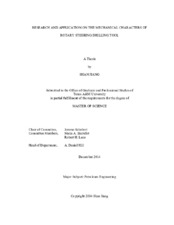| dc.description.abstract | Rotary steerable drilling tool systems (RSS) are ideal for tool integrating downhole automation control and drilling technology, which are used for drilling directional and complex track wells. A simply supported beam model is generally used to research bit side force for point-the-bit RSS tools. The greatest advantage is simplification in the analysis of the bit side force. However, for the side force solution on a point to the bit conditions, the existing literature ignore that this drilling tool system has an outward extended distance. Otherwise the bit in contact with the well wall will form a new support. According to the situation, a point to the bit tool has an outward extended distance; if we ignore this extended distance, and simplify it or just take it as the reaction force of the tool lower bearing support, or side force of the bit a great inaccuracy error will result. Because the beam has an outward extended distance related to the real bit side force, we need more research in this area.
Using to the principle of minimum complementary energy, we can explore the mechanical properties of rotary steerable tools. The rotary steerable tool mandrel force model is based on the mandrel and the rotary steering drilling tool which has three supports; upper and lower bearing and continuous beam model bit. The coordinate system is built in accordance with axial line of orienting rotary steerable drilling tool. The conclusions from the theory analysis and project example calculation in this paper indicate:
RSS technology is a powerful tool for oil exploration and development. It effectively solves technical difficulties in oil and gas exploration and development. Particularly, with regard to higher productivity and fewer drilling risks and downhole accidents with more exposed reservoirs, it delivers excellent performance.
A basic theoretical study of a rotary steering tool system helps us further master the mechanical characteristics of the tool system from the angle of mechanical behavior and features of the tool. In combination with different whipstocking operation principles, we have established different mechanical models to solve the mechanical property parameters, then we can assess the mechanical properties of the RSS. | en |


